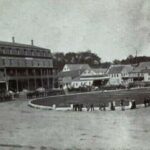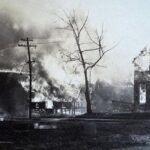Stories from the History of Nashua’s Police and Fire-Rescue Departments.

Prior to the city’s 1853 charter, court was held “by any justice of the peace who could be induced to sit.” This was usually Isaac Spaulding or Israel Hunt Jr. With Nashua’s charter, a “regular court was instituted with General Hunt appointed justice.”
The first “Official” police station was in the basement of City Hall. It was dank, cold and cramped and would soon prove too small. At the time, Nashua’s first City Hall was on the east side of Main Street just north of the Odd Fellows building.
The city charter gave the mayor and aldermen full and exclusive power to appoint a city marshal and assistants, constables, and all other police officers. As first organized, the city had police officers, constables and watchmen. All had the power to arrest. Constables had additional powers to serve civil processes and to collect taxes. It was not unusual for one man to serve in all three positions. None of them was a full-time job, and appointments were often politically driven.
This was a dangerous precedent with the police department tied to city politics. New police officials could be appointed at the beginning of each year and members and officials could be removed just as easily. Subsequently, there were frequent changes. Because the police jobs did not pay a full-time wage members of the department had to hold another job, some in and some outside of the city government.
Early ordinances were vague and left questions in the minds of the police department and subsequently left law open to interpretation. According to an ordinance of 1858, the City Marshal performed patrol duties throughout the city. He was to “…observe all sources of filth, nuisances, obstructions, and impediments and to see that these would be removed and guilty be prosecuted.” Several annual city reports of this period show a large number of these instances reported although it is difficult at best to determine if anyone was actually cited for it.
The City Marshal was also supposed to report all defects in roads and bridges and hear all complaints from citizens about violations of the law. The City Marshal seemed to be a “catch-all” for city officials or department heads that did not yet exist, or did not want to deal with such things. It was a job of many hats!
He was also supposed to “obey all commands and orders from the mayor and aldermen in relation to any matter concerning the city.” With the police heavily beholden to the city politicians and politically dependent on them for their jobs, it made the rule of law almost farcical. One of the most ridiculous things the police were tasked with by the alderman was to build and place throughout the city, birdhouses suitable for the many English Sparrows inhabiting the city.

Nashua’s 1st Annual Report for Fiscal Year (FY) ending March 17, 1854. Police Budget – $0 / Police Expenses $226.77. The first City Marshal for 1853-54 was Ignatius Bagley. It is unknown why no money was budgeted for the Police Department. The following year’s police budget was set at $500. A total of $1,452.74 was spent. The most common arrest that year was for assault and battery.
In their earliest days, the Nashua Police Dept. did not always have a budget to work from – in the typical sense. In most cases, department expenses had to be paid out of monies collected from fines imposed on those convicted of various crimes. Later records will show that the NPD was allotted little or no money, but the Night Watch, those looking for “Thieves and Midnight Marauders” had plenty of funds, these probably coming from a city budget.
Perhaps due to the aforementioned political character of Nashua’s earliest policing efforts, by the city’s second year, City Marshal Ignatius Bagley was replaced with Isaac Eaton. He was also given an Assistant City Marshal, George Robbins. The Annual Report also shows the department now had six Constables and 10 Police Officers. It is unknown how the Constables and Police Officers differed in their duties and authority. It may be surmised that one or the other could handle civil law as opposed to criminal law but that is only a supposition. It could have also meant some worked a day shift while others worked a night shift.
Beginning with the Second Annual Report, there is mention of the “City Farm and House of Correction.” This was a facility used to house the city’s indigent and a jail for prisoners serving short sentences for minor offenses. According to The Nashua Experience: History of the City of Nashua 1673-1978, there is no recorded history of daily life in this facility, an odd mix of “miscreants and the down-trodden.” The house itself had a capacity of 55 persons. In 1868, it had to be rebuilt because of fire damage, costing three times more than the insurance covered. Most inmates performed chores within the building and able-bodied men performed road-work on Nashua’s streets. Writers of the time noted that the place was very well-run, neat and in good order. The matron of the City Farm was the only woman listed in the city reports as a member of the municipal government. Current-day Nashuan’s now know this place as the Nashua Country Club.
Excerpted from “Nashua’s Finest: The History of Law Enforcement in Nashua NH”

Yester-Heros” author Gary Ledoux grew up in Nashua’s Crown Hill area, attending Nashua schools and graduating from Nashua High in 1970. He attended NH Vo-Tech for a time, then moved to Amherst, then Manchester, and Weare. He served as a volunteer on the Amherst Fire Dept from 1974 to 1977. A career in the automotive business took him to Florida and then to southern California. After 48 years, he retired in 2017, moving back to Florida with his wife, Rachel, and two dogs. He has published seven books, including two about Nashua history, and has been a contributing editor or contributor to 10 different magazines.
Gary Ledoux can be reached at mayorclum@yahoo.com








